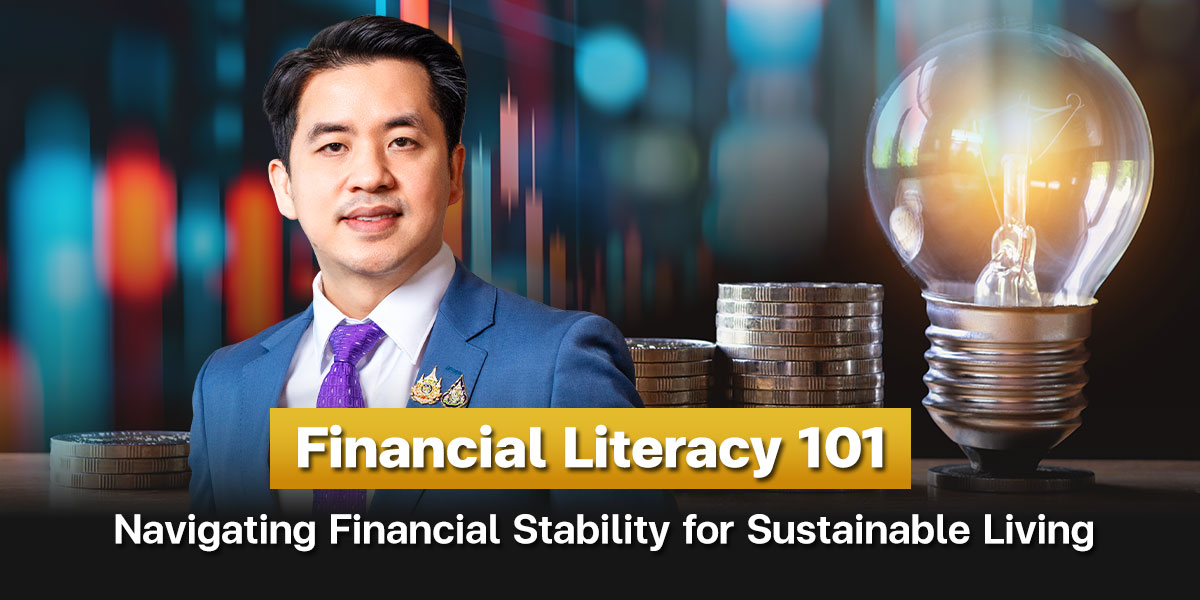Dr. Teerapon Tanomsakyut
Chief of Sustainability & Strategic Development,
Charoen Pokphand Group
Understand and Apply for Sustainable Investment
In a fast-paced world filled with challenges, having “financial literacy” has become a crucial tool to help us navigate through various obstacles with confidence. Many schools around the world are increasingly recognizing this and are adjusting their curricula to prepare students with strong financial skills.
In the U.S. and Canada, the importance of financial education has been introduced as early as high school. For instance, Capital City Public Charter School in Washington, D.C., offers an advanced math course called “Financial Mathematics,” which goes beyond basic calculations to cover topics such as investing, borrowing, credit management, and interest rates. This curriculum is designed to equip students with the skills necessary to handle financial matters with confidence. This initiative is part of a movement that is now present in schools across 30 states in the U.S.
In Ontario, Canada, high school students are required to pass a financial literacy test with a minimum score of 70% to graduate. This course not only focuses on basic savings but also on protecting oneself from financial fraud and managing financial risks carefully.
Financial Literacy 101 is a fundamental subject that everyone must learn to “understand and apply” financial concepts. This knowledge serves as a survival guide in today’s volatile environment. The skills related to “investment”, and “financial security” are not merely about “saving” or “cutting unnecessary spending” as we often think. The focus should be on young children and youth as financial skills need time to develop and practice.
The key phrase here is “understand and apply.” Financial literacy is not just about knowledge, but also about the skills to use that knowledge effectively. To achieve this, a positive mindset is essential, so that people do not perceive financial education as difficult or time-consuming. It should be a mandatory part of school curricula to reach the ultimate goal of what is called “monetary sense” or financial awareness.
In Thailand, financial literacy has gained more attention, especially after the 1997 Asian Financial Crisis, which had a deep impact on both society and individuals. While the economy has somewhat recovered over the past 30 years, it remains clear that many people still struggle financially, with many living paycheck to paycheck and facing ongoing economic challenges.
As of the first quarter of this year, data from the National Credit Bureau reveals that Thailand’s household debt has reached 13.6 trillion baht, an increase of 3% from the previous year. Of this, 8% are classified as “non-performing loans,” totaling 1.09 trillion baht. Among these, auto loan debt is particularly concerning, growing by 32% to 2.38 trillion baht, while credit card debt stands at 63 billion baht, a 14.6% increase. The Bank of Thailand reports that 67% of Thais are in debt that does not generate income, while only 17% are in income-generating debt. Furthermore, one in five Thais has non-performing debt.
While the phrase “cut expenses, increase income” is often touted in Thai society—especially as incomes continue to shrink due to ongoing economic challenges—it is a factor that individuals cannot always control. Nevertheless, I believe that financial literacy can provide some buffer against economic volatility, preventing situations from worsening. At the very least, it can help people live more comfortably and avoid falling into the trap of financial distress.
Financial literacy is not just about managing money in your pocket; it is about managing the financial risks in your life.
The next question is: How can we help people access financial literacy? This is why I started this article with examples from abroad, with the belief that instilling financial knowledge and skills at an early age can help individuals better cope with financial risks in the future. This approach aligns with the Bank of Thailand’s stance and the guidelines from the Organization for Economic Co-operation and Development (OECD), which outlines three success factors for financial literacy:
- Financial knowledge
- Financial behavior
- Financial attitude
Based on this framework, I would like to propose five practical steps to help people of all ages succeed in these three areas, as a guide for Financial Literacy 101.
1) Life Goals – Financial Goals
Setting life goals helps us understand the type of life we want to lead, which in turn allows us to plan how to manage our finances to achieve those goals. This process involves distinguishing between needs and wants in a balanced way. Life goals should include short, medium, and long-term goals. For example, long-term goals might involve setting a retirement target, such as determining how much money you will need after retirement and how you will generate that income. Additionally, goals should be specific and measurable. For example, rather than simply saying, “I want to save money,” say, “I will save 100,000 baht within 3 years.” This approach makes it easier to track progress towards achieving your financial goals.
2) Saving – Start Early
The foundation of financial planning often starts with saving. Setting financial goals may not be difficult, but consistency is the real challenge. I recommend starting to save as early as possible, especially when expenses are still manageable. A good starting point is to save 10-15% of your income and categorize savings for specific purposes, such as education. A minimum savings target should be enough to cover six months of living expenses, which can serve as an emergency fund in case of unforeseen loss of income. This emergency fund can help relieve financial stress and provide time to recover from setbacks.
3) Turn Saving into Investment
A recent survey by the Bank of Thailand found that 87.5% of Thai people save money, but most of this is in cash or savings accounts. Only 2.6% of Thais invest their savings, which is alarmingly low. However, saving and investing have become intertwined, as “money can work for you.” There are many investment products available to diversify risk, such as bonds, stocks, real estate, or life insurance combined with investment (unit-linked). The key idea is that money grows by outpacing inflation, which reduces the value of money over time. For example, if 100 baht could buy 10 cups of coffee (10 baht each), but now it can only buy 5 cups (20 baht each), investing your money can help overcome the effects of inflation.
Investing requires knowledge of interest rates, prices, asset allocation, and risk. Therefore, it is essential to educate yourself on investment options. One useful tool is the Sustainability Index, which ranks companies based on their adherence to sustainable business practices, including Environmental, Social, and Governance (ESG) principles. Companies that score highly on this index show transparency and a commitment to societal and environmental well-being, making them a safer choice for investors.
4) Debt Management – Avoid Bad Debt
Being in debt is not inherently bad; the challenge is managing debt to maintain liquidity. I recommend starting by creating a budget and understanding your debts, so you can plan your spending and repayment strategy. This helps you determine whether your debt is manageable. You should also have a plan for managing debt, such as paying bills on time, considering refinancing options, and building an emergency fund.
5) Manage Taxes to Increase Savings
Paying taxes is a civic duty in Thailand, but tax benefits can also help reduce your overall tax burden. A good tax strategy can ease the financial load, enabling you to channel more money into savings or investments. This begins with tax planning, where you identify types of income and expenses eligible for tax deductions, especially the legal tax exemptions. It is also important to explore investment options that provide tax relief, such as investing in Retirement Mutual Funds (RMF) or Voluntary Provident Funds (PVD).
Conclusion
Financial Literacy 101 is the first step to understanding and managing money effectively. It covers everything from setting goals, saving, and investing, to managing debt and taxes. These financial skills are not just academic concepts—they are life skills that enable us to make informed decisions and face life’s financial challenges with confidence. This article hopes to inspire people to recognize the importance of financial literacy and use it to create a more secure and sustainable life.




